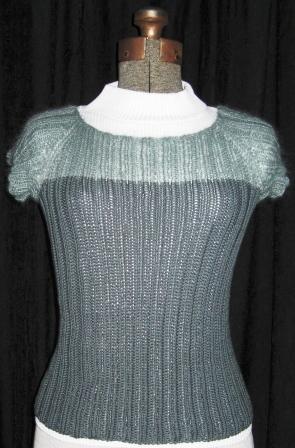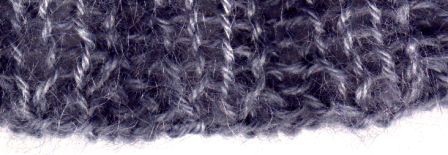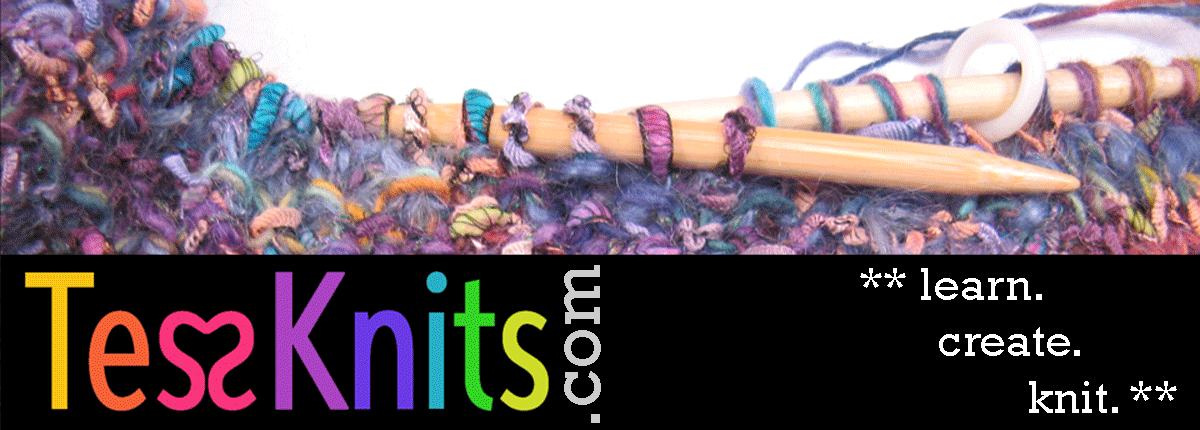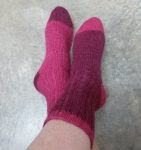One of the biggest problems with knitted ribbing is the relative lack of stretch in the cast-on or bound-off edges.
 Ribbing is almost always at the edges of a garment, and we usually want it to stretch as much as possible. If the cast-on or bound-off edge is too tight, it can break when the ribbing is stretched over a heel or a head.
Ribbing is almost always at the edges of a garment, and we usually want it to stretch as much as possible. If the cast-on or bound-off edge is too tight, it can break when the ribbing is stretched over a heel or a head.
One solution to this problem is to use tubular cast-on and bind-off techniques, but I think those really only work well on 1 x 1 ribbing, especially when you’re using smooth yarns.
Another solution often used on socks is to use multiple strands of yarn in the cast-on — which I see as not so much a solution, as more of a band-aid. If one strand breaks, then the other is there for insurance. (But if one strand is now taking the strain that used to be on two strands, it probably won’t be long before it breaks, too. So if you go this route, don’t procrastinate on fixes!)
CO and BO edges have a different structure than the rest of the knitting, so the lack of stretch is inherent. The only real way to fix that is to get more yarn in there, in some way that is not obviously different from the rest of the fabric.
When I did my “Sassy” sweater, which is all 2 x 2 ribbing, I used a couple of specialized methods – one of which was new to me – to cast on the sleeves and bind off the neck. I think they both worked really well.
These two tricks will work on any ribbing style at all, and both are very simple, clean, and inconspicuous. Easy to memorize and execute, so well worth your time to learn them!
The bind-off is my own invention. I get fed up with the “Surprisingly Stretchy” thing that is so popular because it really seems overly complicated to me, and I don’t like doing it. So I came up with this much simpler solution, and now I don’t use anything else.
Enjoy your stretchy ribbings!
Ribbing Cast-On
 I learned about this one from a student in one of my classes, who was showing off her socks on which she had used this technique. As she explained what she had done, I had one of those “why didn’t I think of that” moments. I was quite pleased with the results on my sleeves; it should work like a charm on any style of ribbing.
I learned about this one from a student in one of my classes, who was showing off her socks on which she had used this technique. As she explained what she had done, I had one of those “why didn’t I think of that” moments. I was quite pleased with the results on my sleeves; it should work like a charm on any style of ribbing.
Step 1: Cast on twice as many stitches as you need for your ribbing.
Step 2: Work the first row of your ribbing pattern, EXCEPT work 2 cast on sts tog for every stitch you would normally work. For my 2 x 2 rib, instead of working [K, K, P, P] I worked [K2tog, K2tog, P2tog, P2tog] over all my cast-on sts. (One-half the sts decreased.)
Then proceed as usual – in this case, in [K2, P2] rib. Simple, no? But very effective and hardly noticeable.
However, if you want a cute little ruffle at your cast-on edge, simply cast on as above and work in stockinette (or whatever) for a few rows, as deep as you want the ruffle to be. Then go into your ribbing or other st pattern, working 2 sts tog for every st on your needles, as above.
Tess’ Simple Stretchy Bind-Off
Here’s the very simple thing that I do, instead of the Surprising thing:
On every knit st in my ribbing, I do a KFB as I bind off.
So for 2 x 2 ribbing, it would start like this:
KFB in first knit st. You now have 2 sts on the right needle, so BO one of them. (This first K st is different from all the rest.)
{K the next knit st, but leave it on the left needle for a moment. Again, you have 2 sts on the right needle, so BO one of them.
Finish the KFB by knitting in the back of the st that you left on the needle, and now letting it drop off the needle. Once again, you have 2 sts on the right needle, so BO one of them.}
Work all purl sts normally and bind them off normally. Repeat between {} for all subsequent knit sts.
I’ve successfully used this technique for toe-up socks using the KFB on anywhere from 40-50% of the ribbing stitches. Here is a pair with a 3 x 2 rib that I experimented on:
I bound off one sock using KFB on 40% of the ribbing stitches (2 knit sts out of every 5 sts).
I bound off the other sock using it on only 20% of the ribbing stitches (1 knit st out of every 5 sts).
That 20% bind-off is a little tight. So I would not suggest using the KFB on anything less than 25%, or 1/4 of your stitches. I think you’ll agree it looks quite tidy.
If you want the edge to be really stretchy, to match the cast-on above, you could bind off using all knits, and doing the KFB on every stitch — because in my opinion PFB is not worth the trouble. I don’t know if this would be unnoticeable, though, because I haven’t had a need to try it. I find that a 50% increase rate usually is plenty stretchy.


2 comments for “Ribbing Solutions for Knitting: Simple Stretchy Cast-On and Tess’ Simple Stretchy Bind-Off”